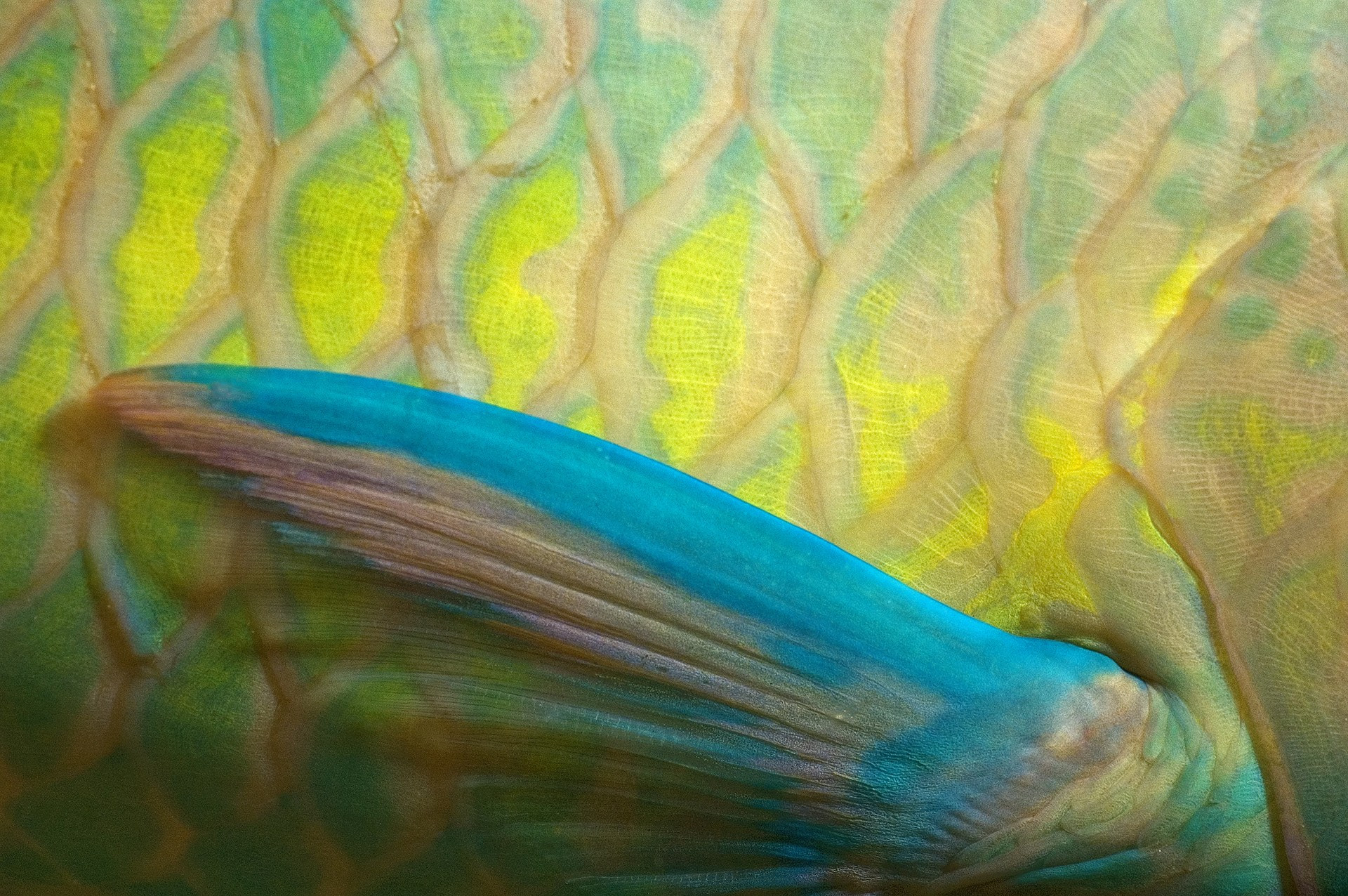There are as many ways of looking at the sea as there are eyes in this world. Some divers search the blue constantly, on the lookout for large silvery fish such as tuna, mobulas and sharks. Others only look right under their noses, diligently scanning the sand for flounders and sting rays. Some are fascinated by the reefscape, enjoying the array of colours and the sun streaks pouring through, while others spend half their dives upside down, searching beneath it for the shy fish that hide in crevices.
As someone who has been diving for more than ten years, both as a scuba instructor and as a marine biologist studying the reefs in Lakshadweep, the Andaman Islands and San Diego, I have had the privilege of seeing the ocean from many different perspectives. None has inspired me more than the perspective of a talented photographer focusing his macro lens on the minute details that are almost entirely lost to the naked eye. These images have been captured over several years by Sumer Verma, one of the most gifted underwater photographers in the country.
Some have been taken on thriving reefs cradled in the rich coral triangle, others on reefs that are now fields of rubble covered with dull macro algae – almost dead at first glance, revealing their beauty only to true believers who continue to seek out the god that is in the details. You’ll find technical tips from Sumer on shooting macros through the photo story.
Sponges are one of the simplest marine animals and they are abundant on most reefs. Lacking in nervous systems, digestive systems or pretty much any organ, they are barely ‘animals’ as we know them and could easily be mistaken as inanimate. They can appear as carpet-like sheets to towering finger-like protrusions to barrels. They are so much a fabric of the ecosystem that they very quickly become a part of the furniture – unnoticed by most. The macro lens reveals their stunning patterns and colours.
Pro Tip: Like with any kind of underwater photography, you have to get as close to the subject as possible. Sometimes, the challenge is that macro lenses offer very little depth of field so it’s difficult to get the whole subject in sharp focus. Overcome this by using closed apertures since all of your light for these kinds of images comes only from the strobes. Also, try to compose the subject parallel to your lens so it’s on the same plane of focus.
Being so wildly different from the eyes that we are used to, the Peacock Mantis Shrimp’s eyes might seem opaque and unseeing, but they have evolved to see the world in more colours than humans can even comprehend. Human eyes have three types of colour photoreceptor cells, allowing us to see the spectrum of the rainbow (VIBGYOR) that we do. Mantis shrimps have 12 types of colour photoreceptor cells in their eyes – so it is speculated that their range of colour reception is far superior to ours. Their kaleidoscopic bodies are a treat to look at, but their shy burrowing behaviour means they disappear in the blink of an eye. Lucky for us then, that the snap of a shutter captures their beauty for posterity.
Pro Tip: The most important element of the subject to make sure is in sharp focus, is the eye.
Like corals, Giant Clams also host zooxanthellae algae in their tissue, which lends them these rich colours and patterns. Beautiful even from afar, giant clams almost invite divers to come wave their hands over their lips and oblige them by galvanising their massive basin-like shells into snapping shut. But up close, their rich golden tones are far more marvellous than the whitish calcium carbonate shells they are killed and collected for.
Parrotfish are almost impossible to miss on a reef. Propelling their rounded bodies forward by flapping their small pectoral fins, they make a racket as they scrape the algae off corals with their big buckteeth, and poop out a stream of pure sand behind. In all this commotion it is easy to miss the elegant Monet-like colouring of their scales and fins, but it would be a shame not to stop and marvel.
Pufferfish are known for many things – the potent toxins in their body that make them an adrenaline-raising delicacy in Japan, their bizarre defence mechanism that makes their body inflate and spike out when threatened, and their awkward slow swimming style. But never have I heard them praised for their pretty blue-tinged eyes and I think it’s about time they received that compliment!
The juvenile Emperor Angelfish begins life with a wildly different appearance than it ends up with. Its electric blue concentric circle pattern slowly transforms into the yellow and blue stripes we are more familiar with when they are adults. As babies, they are shy and hard to spot but almost hypnotic once they are seen. They are as thin as a sheet of paper and almost non-existent when seen directly from in front – this is one of their techniques to escape predation. Their faces have the same patterns as their tails so that when seen from the side their predators must guess which way their head is and therefore in which direction they might travel. Their vibrant patterns are said to have evolved to imitate a toxic flatworm, which predatory fish generally avoid.
Pro Tip: Compose your shots intelligently and create magical backdrops for your subjects. You can even experiment with making the background pure black, which allows the subject to jump out at you.
Feather Worms are common on reefs. Tiny beings, they wave their feathery appendages out in the water to catch the passing plankton to feed upon. It is hard to observe them up close and really get a sense of their colours and patterns though, as they retract their feathers into their tube-like structures at even the hint of a threat, like the slightest change in water flow caused by a moving animal. The camera, patiently held still, manages to capture their beauty.
Pro Tip: Try to capture some kind of behaviour – that always adds an extra element to your image. It is important to be patient for that perfect moment or for the peak of whatever action you are trying to capture.
Sea Stars fascinate newbie divers but experienced ones tend to ignore them and take them for granted. To me, this picture is a message to look at the world with the eye of a child (or a new diver) and the detail of a microscope (or a macro lens) for its beauty is as much in the details as it is in its vast scale and magnitude.
Nudibranchs are the snails of the sea – although closely related to their terrestrial cousins, over time they have lost their external shells. Shells take a lot of energy to make and then carry around, but they do offer these slow-moving, soft-bodied animals important protection. Nudibranchs sidestep this problem very creatively. They feed on sponges, hydroids and other toxic sea life, but rather than get poisoned by them, they harvest their prey’s stinging cells to make themselves poisonous. And their brightly coloured bodies send a strong ‘don’t eat me!’ signal to predators.
Catfish get their name from the barbels around their mouths which look uncannily like a cat’s whiskers. The barbels are like extended taste buds – they use them to rustle around the seabed looking for food that might be under the sand. As catfish are usually toothless, they suck and swallow their food rather than chewing it. There are species of catfish found in almost all the waters of the world – salty and fresh. The smallest ones grow only to about 1cm long while the largest catfish, a species found only in the Amazon basin, reaches around 3.5 metres! In 2008, Jeremy Wade, a British biologist and professional angler, caught a 80 kg Goonch catfish in the Kali river in India which locals believed had become a man-eater.
Pro Tip: Always take care to be aware of your depth and bottom time. Make sure you don’t damage the reef in any way or harass the little creatures you are trying to photograph.
A third of all life in the ocean is found on coral reefs that occupy less than 1 per cent of its surface! So as you can imagine, it is absolutely teeming with life. Everywhere you stop on a reef and look closely you see life upon life upon life. You might see tiny Partner Shrimp, which, through some remarkable camouflage, share a symbiotic relationship with coral or other reef species.
Coral Groupers have some of the most phenomenal colours. Common residents of a coral reef, they are mid-level predators that feed on smaller fish and invertebrates. They hunt by opening their large mouths very rapidly to create suction and swallow their food whole. Groupers are one of the many fish on the reef that are sequential hermaphrodites – they change their sex over the course of their lives. They are all born females and the largest individual in that territory changes into a male. If something should happen to this male – such as being eaten or fished out – the next biggest female changes her gender and takes over the role.
Ornate Ghost Pipefishes are related to pipefish and seahorses. In true pipefish and seahorses, the males are entrusted with parental duties – a female will lay her eggs into the male’s ‘brood pouch’ and leave him to nurture the offspring with nutrients and oxygen through a placenta-like connection. But in ghost pipefish, also known as ‘false pipefish’, the female broods the eggs. These fish spend most of their lives in open waters, only coming to coral reefs during the breeding season. They feed on tiny crustaceans that they suck in through their straw-like snout.
Pro Tip: There are millions of beautiful tiny creatures in the reef waiting to be discovered. Go out and have fun!















